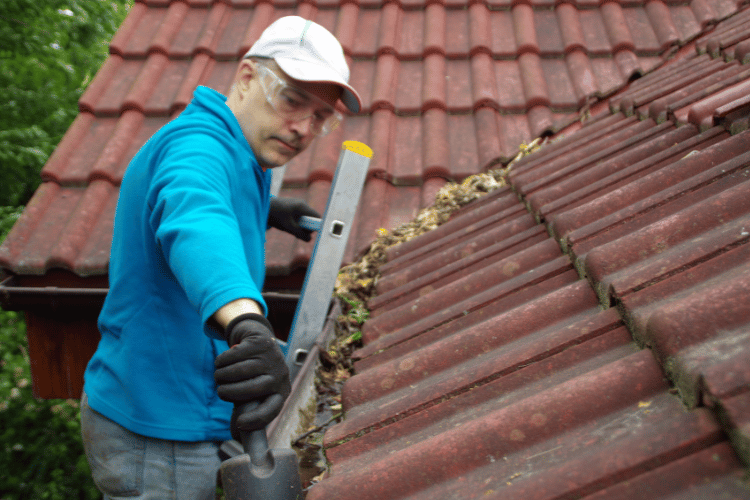Gutters are the unsung heroes of your home, quietly directing rainwater away from your roof, walls, and foundation. But when they’re clogged with leaves, twigs, and debris, they can’t do their job effectively. Water overflows, damage creeps in, and suddenly, you’re facing costly repairs. That’s where DIY gutter cleaning comes in—a practical, money-saving skill every homeowner should master.
In this ultimate guide, we’ll walk you through everything you need to know to clean your gutters safely and efficiently, from preparation to finishing touches. By the end, you’ll be equipped to tackle this essential maintenance task like a pro.
Why Gutter Cleaning Matters
Before diving into the how-to, let’s talk about why gutter cleaning is worth your time. Gutters protect your home by channeling water away from vulnerable areas. When they’re clogged, the consequences can be severe:
- Roof Damage: Water trapped by debris can seep under shingles, leading to leaks or rot.
- Foundation Issues: Overflowing gutters dump water near your foundation, potentially causing cracks or flooding.
- Siding and Paint Damage: Water spilling over can stain or peel exterior walls.
- Pest Problems: Clogged gutters become breeding grounds for insects, rodents, and even birds.
Regular cleaning—typically twice a year, in spring and fall—prevents these headaches. Doing it yourself saves you the cost of hiring a professional (often $100-$300 per visit) and gives you control over the process. Plus, it’s a satisfying way to care for your home.
Essential Tools & Equipment You’ll Need
A successful DIY gutter cleaning starts with the right gear. Here’s what to gather before you begin:
- Sturdy Ladder: A 6- or 8-foot step ladder works for single-story homes; extension ladders are better for two-story houses. Ensure it’s rated for your weight and has non-slip feet.
- Gloves: Thick, waterproof work gloves protect your hands from sharp debris and bacteria-laden muck.
- Gutter Scoop or Trowel: A plastic scoop (available at hardware stores for $5-$10) is ideal for scooping out debris. A garden trowel works in a pinch.
- Bucket or Tarp: Use a bucket with a ladder hook to collect debris, or lay a tarp below to catch what you toss down.
- Garden Hose: A hose with a spray nozzle clears small debris and tests water flow.
- Safety Glasses: Protect your eyes from falling dirt and dust.
- Trash Bags: For easy disposal of gutter gunk.
- Optional Power Tools: A leaf blower or pressure washer can speed up the job, but they’re not essential.
Pro tip: Invest in a ladder stabilizer (around $30-$50). It attaches to the ladder and rests against your roof, keeping you steady and preventing gutter damage.
Also Read: Top Signs Your Gutters Need Immediate Repair
Safety First: Preparing for the Job
Gutter cleaning isn’t inherently dangerous, but it involves heights and ladders, so safety is non-negotiable. Follow these steps to minimize risks:
- Check the Weather: Avoid cleaning on windy, rainy, or icy days. Dry, calm conditions are best.
- Inspect Your Ladder: Ensure rungs are secure and the base is level. Place it on firm, flat ground—never on uneven grass or mud.
- Wear Proper Gear: Non-slip shoes, long sleeves, and pants reduce the chance of slips or scrapes.
- Work with a Buddy: Have someone nearby to hold the ladder or assist in an emergency.
- Avoid Overreaching: Move the ladder as needed instead of stretching too far, which can tip you over.
If your roof is steeply pitched or your gutters are more than two stories up, consider hiring a pro. Safety outweighs savings in those cases.
Step-by-Step Guide to DIY Gutter Cleaning
Now, let’s get to the nitty-gritty. Here’s how to clean your gutters from start to finish.
Step 1: Set Up Your Workspace
Position your ladder near a corner or downspout—areas that often collect the most debris. Lay a tarp below to catch what falls, or hook a bucket to the ladder. If using a hose, ensure it reaches your work area. Put on your gloves and safety glasses, and climb up carefully.
Step 2: Clear Large Debris
Start by hand-scooping the big stuff—leaves, twigs, pine needles, and any random surprises (tennis balls, anyone?). Use your gutter scoop or trowel to dig into packed debris. Drop it into your bucket or onto the tarp. Work in small sections, moving the ladder as you go. Don’t rush—steady progress beats a hasty fall.
If debris is wet and heavy, it might stick to the gutter. Gently pry it loose with your scoop, being careful not to dent aluminum gutters or dislodge brackets.
Step 3: Flush with Water
Once the bulk is gone, grab your garden hose. Starting at the end farthest from the downspout, spray water along the gutter to wash away smaller particles like dirt, shingle grit, and leftover leaf bits. Aim the spray toward the downspout to encourage flow. If water pools instead of draining, there’s likely a clog ahead—keep this in mind for the next step.
Step 4: Unclog Downspouts
Downspouts are the exit ramps for gutter water, and they’re prone to blockages. Signs of a clog include water backing up or trickling out slowly. To clear it:
- Check the Opening: Remove any visible debris at the top of the downspout.
- Blast with Water: Insert the hose into the downspout from the bottom (if accessible) and spray upward. A strong jet often dislodges clogs.
- Use a Plumber’s Snake: For stubborn blockages, feed a snake or long wire up from the bottom to break through.
Test the flow by running water through the gutter again. It should rush down the spout freely.
Step 5: Inspect and Rinse
With debris gone, take a moment to inspect your gutters. Look for rust, loose brackets, or cracks—minor issues you can fix now (more on that later). Then, give the entire system a final rinse with the hose to ensure it’s spotless and flowing properly.
Step 6: Clean Up
Empty your bucket or gather debris from the tarp into trash bags. Coil your hose, store your tools, and give yourself a pat on the back—you’ve just saved your home from water woes.
Troubleshooting Common Gutter Problems
Sometimes, cleaning reveals underlying issues. Here’s how to handle them:
- Leaks: Small holes or seam gaps can often be patched with gutter sealant (about $10 a tube). Clean and dry the area first, then apply generously.
- Sagging Gutters: Tighten loose brackets with a screwdriver. If they’re bent, replace them—new brackets cost $1-$3 each.
- Rust: Sand off light rust with steel wool and coat with rust-resistant paint. Severe rust may mean it’s time for new gutters.
- Improper Slope: Gutters should tilt slightly toward downspouts (about 1/4 inch per 10 feet). Adjust brackets if water pools.
For major damage, like cracked sections or detached downspouts, consult a professional unless you’re handy with repairs.
When to Clean: Timing Is Everything
Timing your gutter cleaning maximizes efficiency. Most experts recommend:
- Spring: After pollen and blossoms fall, clearing out light debris.
- Fall: After leaves drop, tackling the heaviest buildup.
However, your schedule might vary. Homes near pine trees (which shed needles year-round) or in windy areas may need quarterly cleanings. Watch for overflow during rain or piles of debris on your roof—these are cues to grab your ladder.
Advanced Tips for Gutter Cleaning Pros
Ready to level up? Try these tricks:
- Use a Leaf Blower: With a gutter attachment (around $20), you can blast debris out from the ground. It’s fast but messy—keep that tarp handy.
- Pressure Washer Option: A low-pressure setting clears stubborn grime, but avoid high pressure—it can damage gutters.
- Install Gutter Screens: After cleaning, add screens or guards ($1-$5 per foot) to reduce future buildup. They’re not foolproof but cut maintenance time.
- Check from the Roof: If you’re comfortable, climb onto a low-pitched roof with a harness to scoop debris from above. It’s quicker for some layouts.
Maintenance Between Cleanings
Keep gutters in top shape year-round with these habits:
- Trim overhanging branches to limit leaf drop.
- Sweep your roof occasionally to stop debris from washing into gutters.
- After storms, peek at your gutters for new clogs or damage.
A little vigilance goes a long way.
DIY vs. Professional Cleaning: When to Call It Quits
DIY gutter cleaning is rewarding, but it’s not for everyone. Consider hiring a pro if:
- Your home is multi-story, and you lack a tall, stable ladder.
- You’re uneasy with heights or have mobility issues.
- Gutters are severely damaged or clogged beyond your tools’ reach.
Professionals charge $100-$300 depending on home size and gutter condition—still cheaper than repairing water damage.
The Satisfaction of a Job Well Done
Cleaning your gutters isn’t glamorous, but it’s a win for your home and wallet. Picture this: rain pours down, and instead of pooling around your foundation or leaking through your ceiling, it flows smoothly through spotless gutters. That’s the peace of mind DIY gutter cleaning delivers.
With the right tools, a solid plan, and a bit of elbow grease, you’ve got this. Start small—maybe one section of gutter this weekend—and build your confidence. Soon, you’ll be the go-to gutter expert in your neighborhood.
Final Checklist
Before you climb that ladder, run through this:
- Tools ready? Ladder, gloves, scoop, hose, bucket/tarp, safety glasses.
- Weather clear? No rain or wind.
- Buddy on standby? Check.
- Plan in place? Start at corners, work toward downspouts, flush, and inspect.
Now, go conquer those gutters. Your home will thank you.
Need Help with Gutter Cleaning? Call the Experts!
DIY gutter cleaning can be time-consuming and risky, especially for multi-story homes. If you prefer a hassle-free solution, our professional team is here to help! We provide thorough, efficient, and safe gutter cleaning services to protect your home from costly damage.
✅ Fast & Reliable Service
✅ Experienced Professionals
✅ Affordable Pricing
📞 Call us today at (877) 631-6098 to schedule your gutter cleaning service! Keep your home safe and your gutters in top condition.
FAQs – Frequently Asked Questions
How often should I clean my gutters?
Clean gutters twice a year—spring and fall—or more if you have overhanging trees. Regular maintenance prevents clogs, water damage, and costly repairs, keeping your home safe and dry.
What tools do I need for DIY gutter cleaning?
You’ll need a sturdy ladder, gloves, gutter scoop, bucket or tarp, garden hose, and safety glasses. Optional tools like a leaf blower or ladder stabilizer can make the job easier and safer.
Is it safe to clean gutters myself?
Yes, if you use a stable ladder, avoid overreaching, and work in dry weather with a buddy. For high or steep roofs, consider hiring a pro to avoid risks.
Can I clean gutters without a ladder?
Yes, with a leaf blower and gutter attachment or a long pole tool from the ground. These methods work best for single-story homes with light debris.
What are the risks of neglecting gutter cleaning?
Clogged gutters cause water overflow, leading to roof leaks, foundation damage, mold growth, and pest infestations. Regular maintenance prevents costly repairs and protects your home’s structure.
When should I call a professional for gutter cleaning?
If your gutters are severely clogged, hard to reach, or you lack proper tools, hiring professionals ensures thorough cleaning and prevents injury or damage.






Leave a Reply